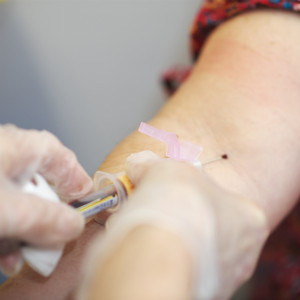Five pearls of wisdom
1. With anaemia, the MCV is the most useful initial guide to causation
Microcytosis suggests iron deficiency (but see point below). Mild iron deficiency can be confused with thalassaemia trait – see the ‘Easily Confused’ section below. The anaemia of chronic disease can be microcytic in approximately 25% of patients. A macrocytosis suggests B12 or folate deficiency and in the older patient may indicate myelodysplasia. Macrocytosis can also be seen with liver disease, haemolysis and hypothyroidism. A normal MCV with low white cells or platelets may suggest an underlying bone marrow disorder.
2. Iron deficiency may still be the cause of anaemia, even with a normal MCV and ferritin – especially in the elderly
Around 40% of individuals with iron deficiency anaemia may have a normal MCV. The sensitivity of a low ferritin (<15µg/L) for iron deficiency is only 59%, but 98% if it’s <40 µg/L. The transferrin (iron) saturation (Tsat) is a useful test in these circumstances. This is widely available but usually only carried out for high ferritin levels. If the Tsat is <15% it is likely that the individual is iron deficient. If in doubt, and a Tsat is not available, a short 4–6 week trial of oral iron is worthwhile.
3. Not all low B12 results mean true deficiency
The B12 assay is not very sensitive or specific. Borderline low levels (up to 25% below the local reference range) may not represent true deficiency. Falsely normal levels can also occur. Clinical features such as glossitis, paraesthesiae, unsteadiness or a peripheral neuropathy make true deficiency more likely. A macrocytic anaemia, especially with an MCV of >110fl, and hypersegmented polymorphs on a blood film are also suggestive of true deficiency. If in doubt, repeat testing 1-2 months later can be useful, with a persistently low or progressively decreasing B12 indicative of true deficiency. With a suggestive clinical picture, a trial of B12 can be given, even if the B12 level is normal.
4. Long-standing neutropenia is likely to be benign
Long-standing, isolated, non-progressive neutropenia is usually benign and does not generally require referral. In Afro-Caribbean patients it is probably benign ethnic neutropenia. Neutropenia may be autoimmune and can be associated with other autoimmune disorders, such as lupus. B12 or folate deficiency can also cause a neutropenia. Regular FBCs are usually not necessary and should be done only if there is a good clinical reason. Infection risk only really begins to increase with neutrophils of <0.5 × 109/L. Recent, unexplained neutropenia, especially if progressive, < 0.5 × 109/L or associated with other cytopenias, should lead to an urgent haematology referral.
5. In most cases of mild bruising or bleeding, the history is more informative than laboratory tests
Most of these cases are benign. Single site bleeding, such as nosebleeds or menorrhagia, is usually due to a local problem. Persistent or recurrent bleeding without a local cause may be due to a coagulation abnormality such as von Willebrand’s disease. Extensive, non-traumatic bruising, multiple site bleeding, excessive bleeding from cuts, previous trauma, surgery, dental extraction and childbirth as well as a family history of excessive bruising or bleeding suggest a coagulation abnormality. Bruising on the forearms and hands in the elderly is probably age-related and can be made worse by steroids, anticoagulants, aspirin, clopidogrel and NSAIDs. Mild bruising in young women, especially confined to the limbs, is usually benign. The best initial screening tests are a platelet count, prothrombin time (PT) and activated partial thromboplastin time (aPTT).
Obscure or overlooked diagnoses
1. Haematological malignancies
There are only six or seven per practice per year. The most common, especially in those over 60, are lymphomas, chronic lymphatic leukaemia, myeloma and monoclonal gammopathy of undetermined significance (MGUS). Features include unexplained weight loss, fever, drenching night sweats, non-tender lymphadenopathy, splenomegaly and new bone or back pain. Suggestive blood tests include recent, unexplained cytopenias, especially pancytopenia, blood films containing blasts or that are leucoerythroblastic (presence of nucleated RBCs and immature WBCs), lymphocytosis, new hypercalcaemia or renal failure.
2. Coeliac disease and angiodysplasia
While iron deficiency is commonly due to menorrhagia or gastrointestinal bleeding, it can also be due to malabsorption – as in coeliac disease, where the combination of iron and folate deficiency is suggestive. Up to 10% of gastrointestinal bleeding is from the small bowel that is not amenable to endoscopy. The most common source is from dilated, tortuous, thin-walled blood vessels – angiodysplasia.
3. Antiphospholipid syndrome
This is associated with early or late pregnancy loss and an increased risk of arterial or venous thrombosis. It can also present with thrombocytopenia or a prolonged aPTT. Diagnostic tests include lupus anticoagulant and anticardiolipin and beta-2 glycoprotein 1 antibodies. With antibodies, usually only moderate to high levels are significant (>40 units). A firm diagnosis can only be made if positive tests remain positive on retesting after 12 weeks.
4. Benign abnormalities in pregnancy
Some haematological abnormalities seen in pregnancy are benign:
- Leucocytosis up to 16 × 109/L can occur without evidence of infection.
- A mild fall in platelets in the second and third trimester, rarely <70 × 109/L.
- An increased MCV.
- Low B12.
Easily confused
Iron deficiency and thalassaemia trait
| Iron deficiency | Thalassaemia trait |
|---|---|
|
Decreased Hb |
Hb mildly decreased or normal
|
|
Modest decrease in MCV |
Marked decrease in MCV |
|
Decreased ferritin |
Normal ferritin |
|
Other features: – decreased MCH and MCHC – decreased RBCs – increased RDW |
Other features: – decreased MCH; MCHC normal or slightly decreased – normal or increased RBCs – normal RDW – HbA2 increased with beta-thalassaemia trait – HbA2 normal with alpha- thalassaemia trait – suggestive ethnic origin
|
MGUS (monoclonal gammopathy of undetermined significance) and myeloma
| MGUS | Myeloma |
|---|---|
|
Low concentration paraprotein: – IgG <20g/L – IgA <15g/L – IgM <5g/L – IgM <5g/L
|
High concentration paraprotein, usually >30g/L Usually associated with IgG and IgA paraproteins |
|
Other immunoglobulins normal |
Other immunoglobulins may be decreased |
|
Hb, creatinine and calcium usually normal |
Hb can be decreased Creatinine and calcium can be increased |
|
Urine negative for Bence Jones protein (BJP) |
Urine may be positive for BJP
|
|
No lytic lesions on X-rays |
X-rays may show lytic lesions |
|
Action required: – 6 monthly follow up by GP – refer with increasing paraprotein plus – symptomatic – unexplained anaemia – decreasing renal function – hypercalcaemia
|
Action required: – two week referral to haematology |
Benign lymphadenopathy and malignant lymphadenopathy
| Benign lymphadenopathy | Malignant lymphadenopathy |
|---|---|
|
Localised: – underlying local cause (eg infection) – usually resolves within 4-6 weeks
|
Generalised (if localised then no obvious cause and doesn’t resolve, or shows progressive enlargement) |
|
Tender: – mobile – <1cm |
Non tender: – fixed – hard or rubbery |
|
Local symptoms or asymptomatic |
Systemic symptoms with fever, weight loss, drenching night sweats
|
Prescribing points
1. Oral iron
Only use with proven iron deficiency (low ferritin or transferrin saturation). Give a full therapeutic dose and continue for at least three months. Check the Hb response after a month and the Hb and ferritin after three months. Failure to respond can be associated with inadequate dosing, poor patient compliance, malabsorption, continuation of the underlying cause (usually bleeding), or coexisting, active conditions such as infection, inflammation, cancer or renal failure.
2. When should an antiplatelet agent (APA) be given or continued when oral anticoagulation is also indicated?
- For the first 12 months following a myocardial infarction treated medically or following percutaneous intervention with coronary artery stent insertion.
- After coronary artery bypass grafts, although after one year an APA may not be necessary after an internal mammary artery graft.
- If an OAC is required an existing APA can be stopped if it is being used for:
- peripheral arterial disease
- a previous non-atrial fibrillation stroke
- an MI sustained more than 12 months previously with stable ischaemic heart disease
- an MI treated with PCI more than 12 months previously
3. Anticoagulation for VTE
NOACs are now the anticoagulant of choice. They have the same efficacy as low molecular weight heparin and warfarin, but are safer with less risk of bleeding. In general, VTEs provoked by COCP, pregnancy, surgery, hospital admission, immobility or long-haul plane flight need only three months of anticoagulation. Unprovoked VTEs, especially in men, have a higher risk of recurrence and long- term anticoagulation should be considered.
This is an abridged version of a chapter in Instant Wisdom, a guide for GPs distilling years of knowledge, experience, and key evidence into 25 easy-to-read chapters, each one covering a different speciality. Pulse is offering an exclusive 15% discount to GPs on the recommended retail price. To take advantage of this offer, visit www.crcpress.com/9781138196209 and enter PUL15 at the checkout.

instant wisdom cover pic
Pulse October survey
Take our July 2025 survey to potentially win £1.000 worth of tokens

Visit Pulse Reference for details on 140 symptoms, including easily searchable symptoms and categories, offering you a free platform to check symptoms and receive potential diagnoses during consultations.











